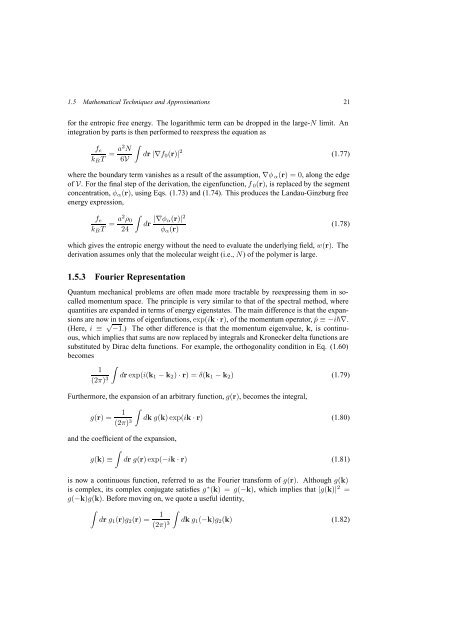Self-Consistent Field Theory and Its Applications by M. W. Matsen
Self-Consistent Field Theory and Its Applications by M. W. Matsen
Self-Consistent Field Theory and Its Applications by M. W. Matsen
You also want an ePaper? Increase the reach of your titles
YUMPU automatically turns print PDFs into web optimized ePapers that Google loves.
1.5 Mathematical Techniques <strong>and</strong> Approximations 21<br />
for the entropic free energy. The logarithmic term can be dropped in the large-N limit. An<br />
integration <strong>by</strong> parts is then performed to reexpress the equation as<br />
∫<br />
f e<br />
k B T = a2 N<br />
dr |∇f 0 (r)| 2 (1.77)<br />
6V<br />
where the boundary term vanishes as a result of the assumption, ∇φ α (r) =0, along the edge<br />
of V. For the final step of the derivation, the eigenfunction, f 0 (r), is replaced <strong>by</strong> the segment<br />
concentration, φ α (r), using Eqs. (1.73) <strong>and</strong> (1.74). This produces the L<strong>and</strong>au-Ginzburg free<br />
energy expression,<br />
∫<br />
f e<br />
k B T = a2 ρ 0<br />
24<br />
dr |∇φ α(r)| 2<br />
φ α (r)<br />
(1.78)<br />
which gives the entropic energy without the need to evaluate the underlying field, w(r). The<br />
derivation assumes only that the molecular weight (i.e., N) of the polymer is large.<br />
1.5.3 Fourier Representation<br />
Quantum mechanical problems are often made more tractable <strong>by</strong> reexpressing them in socalled<br />
momentum space. The principle is very similar to that of the spectral method, where<br />
quantities are exp<strong>and</strong>ed in terms of energy eigenstates. The main difference is that the expansions<br />
are now in terms of eigenfunctions, exp(ik · r), of the momentum operator, ˆp ≡−i∇.<br />
(Here, i ≡ √ −1.) The other difference is that the momentum eigenvalue, k, is continuous,<br />
which implies that sums are now replaced <strong>by</strong> integrals <strong>and</strong> Kronecker delta functions are<br />
substituted <strong>by</strong> Dirac delta functions. For example, the orthogonality condition in Eq. (1.60)<br />
becomes<br />
∫<br />
1<br />
(2π) 3 dr exp(i(k 1 − k 2 ) · r) =δ(k 1 − k 2 ) (1.79)<br />
Furthermore, the expansion of an arbitrary function, g(r), becomes the integral,<br />
g(r) = 1 ∫<br />
(2π) 3 dk g(k)exp(ik · r) (1.80)<br />
<strong>and</strong> the coefficient of the expansion,<br />
∫<br />
g(k) ≡ dr g(r)exp(−ik · r) (1.81)<br />
is now a continuous function, referred to as the Fourier transform of g(r). Although g(k)<br />
is complex, its complex conjugate satisfies g ∗ (k) =g(−k), which implies that |g(k)| 2 =<br />
g(−k)g(k). Before moving on, we quote a useful identity,<br />
∫<br />
dr g 1 (r)g 2 (r) = 1 ∫<br />
(2π) 3 dk g 1 (−k)g 2 (k) (1.82)
















